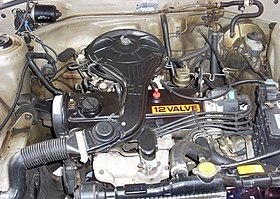Toyota Tazz: The Compact Car That Delivers on Reliability and Fuel Efficiency
Toyota Tazz: The Compact Car That Delivers on Reliability and Fuel Efficiency
Blog Article
Check Out the current Trends in Engine Innovation With Tazz
In the swiftly progressing landscape of auto innovation, Tazz stands at the forefront, highlighting substantial improvements in engine systems that focus on both innovation and sustainability. tazz. From hybrid engines that maximize fuel performance to the appearance of hydrogen fuel cells, the patterns forming modern powertrains are not just enhancing efficiency but additionally resolving vital environmental obstacles. As the market continues to press limits, it is important to think about how these developments will certainly affect future transportation services and the more comprehensive effects for global power usage. What exists in advance in this crucial transformation?
Hybrid Engine Innovations
Hybrid engine technologies represent a critical shift in automotive innovation, combining the advantages of interior combustion engines with electrical propulsion systems. This combination not just enhances gas performance but likewise decreases exhausts, conference increasingly stringent environmental guidelines. By using both power sources, hybrid engines can optimize efficiency, delivering power when required while saving gas during much less requiring motoring problems.
Current innovations in hybrid innovation include enhancements in battery efficiency and regenerative stopping systems. These technologies allow for greater energy recuperation throughout slowdown, which can be redirected to assist in velocity or power accessory systems. Producers are concentrating on small styles and light-weight materials to make the most of the performance of hybrid powertrains.
The growth of plug-in hybrids has actually likewise increased the marketplace, making it possible for drivers to bill their lorries using conventional electric outlets. This function frequently allows for substantial all-electric array, more lowering dependancy on traditional fuels. tazz. As the auto sector remains to develop, hybrid engine innovations are expected to play an essential duty in connecting the gap between conventional lorries and fully electric designs, supplying a transitional solution that deals with varied consumer needs and choices
Breakthroughs in Electric Powertrains
The vehicle landscape is swiftly evolving, with electrical powertrains becoming a leading pressure in lasting transport. Advances in electric automobile (EV) technology are dramatically improving efficiency, efficiency, and user experience. Trick developments consist of renovations in battery chemistry, which have actually increased power density, reduced charging times, and prolonged total battery life.
Solid-state batteries, for instance, guarantee to reinvent the market by giving greater security and performance contrasted to standard lithium-ion cells. Moreover, developments in regenerative braking systems are making it possible for lorries to recover energy during slowdown, contributing to general effectiveness.
In addition to battery modern technology, electrical motor layouts are coming to be extra innovative. Developments such as incorporated electric motors and advanced thermal administration systems are aiding to enhance power shipment and minimize weight, eventually boosting lorry dynamics.

Collectively, these advances underscore the commitment to transition towards cleaner, much more efficient transportation remedies, placing electric powertrains at the leading edge of automobile advancement.
The Rise of Hydrogen Gas Cells
Significantly, hydrogen fuel cells are getting traction as a feasible choice to conventional inner combustion engines and battery electric cars. This technology utilizes the chemical energy saved in hydrogen, converting it into electrical power through an electrochemical response with oxygen. The primary result of this process is water, making hydrogen gas cells an eco friendly choice with no emissions at the tailpipe.

Automakers are progressively buying hydrogen gas cell innovation, identifying its potential for long-range applications and rapid refueling capabilities that rival conventional fuels. Additionally, sectors such as sturdy transportation and public transportation are especially fit for hydrogen fuel cells, where battery electric services might fail because of weight and range restrictions.
As study and investment remain to increase, hydrogen fuel cells are poised to play a considerable role in the future landscape of tidy transportation and power remedies.
Enhancements in Internal Burning Engines
Innovations in internal combustion engine (ICE) modern technology are changing conventional cars to satisfy modern environmental standards and performance expectations. Among one of the most significant improvements involves the assimilation of advanced gas injection systems. These systems enhance the air-fuel mixture, boosting burning performance and resulting in decreased emissions. Straight gas injection, as an example, permits better atomization of fuel, resulting in more complete combustion and boosted power outcome.
Furthermore, turbocharging has gained prestige, enabling smaller engines to supply greater efficiency without the weight of bigger engines - tazz. This modern technology not just increases efficiency however likewise adds to reduce gas usage. Variable valve timing systems are also being improved, making it possible for engines to adjust to numerous driving conditions for boosted torque and responsiveness
Additionally, using light-weight products in engine construction is ending up being typical, additional improving fuel efficiency by decreasing total automobile weight. Engine control systems (ECUs) are increasingly sophisticated, allowing real-time changes that maximize efficiency and emissions.
These improvements collectively symbolize a critical change in ICE technology, lining up with international sustainability goals while still supplying the efficiency motorists expect from their cars. As the sector progresses, these enhancements remain to shape the future of typical vehicle engineering.
Future Trends in Engine Performance
Substantial developments in engine performance are prepared for as suppliers concentrate on integrating sophisticated modern technologies to meet rigorous environmental laws and consumer demands. The change read this in the direction of electrification, crossbreed systems, and different gas is improving the auto landscape, driving Get More Information advancements that improve fuel economic climate and decrease emissions.
Among the vital fads is the execution of sophisticated products and producing strategies. High-strength alloys and lightweight composites add to decreased automobile weight, thus enhancing total effectiveness. In addition, the adoption of turbocharging and variable shutoff timing modern technologies enables improved power outcome from smaller engines, additionally boosting fuel economy.

Final Thought
In verdict, the exploration of engine innovation exposes considerable developments that prioritize sustainability and efficiency. Innovations in crossbreed engine systems, electric powertrains, and hydrogen gas cells show a commitment to minimizing exhausts while boosting efficiency. Improvements in inner burning engines and a advice focus on light-weight materials add to general engine efficiency. As the auto industry proceeds to advance, these patterns will play a vital duty fit a cleaner and more sustainable future for transport.
From hybrid engines that maximize gas effectiveness to the emergence of hydrogen fuel cells, the trends forming modern powertrains are not just boosting efficiency yet additionally resolving important ecological obstacles.Crossbreed engine technologies stand for an essential shift in vehicle technology, integrating the benefits of interior burning engines with electric propulsion systems.In addition, turbocharging has gotten prominence, permitting smaller sized engines to supply higher efficiency without the weight of bigger engines. Additionally, the adoption of turbocharging and variable valve timing innovations enables for boosted power outcome from smaller engines, further enhancing fuel economy.
Improvements in inner combustion engines and a focus on light-weight products add to total engine performance.
Report this page